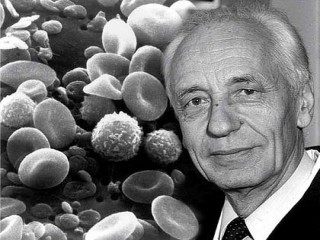
Jean Dausset biography
Date of birth : 1916-10-19
Date of death : 2009-06-06
Birthplace : Toulouse, France
Nationality : French
Category : Science and Technology
Last modified : 2011-12-21
Credited as : scientist, Recognition of HLA antigens, Nobel laureate
0 votes so far
Dausset received the Nobel Prize in Physiology or Medicine in 1980 along with Baruj Benacerraf and George Davis Snell for their discovery and characterisation of the genes making the major histocompatibility complex.
Dausset was convinced by his father to study medicine at the University of Paris. Both of Dausset’s parents died just after he became an extern at the Paris Hospitals, at the age of 19. Dausset failed to pass an internship entrance exam at the Paris Hospitals, and was preparing for a second attempt when World War II broke out.
Dausset was enlisted in the French army, and sent off to Northern Italy for a year. Upon his return to Paris in 1940, Dausset studied ardently and passed his medical internship exam. Soon after passing his exams, Dausset joined the Free French Forces in North Africa as an ambulance worker. He was originally stationed in Morocco, but was later sent to the more active Tunisia. Dausset got his first taste of hematology when he had to perform numerous blood transfusions on wounded soldiers. As the war was winding down in 1944, Dausset returned to Paris where he worked in the Regional Blood Transfusion Center at the Saint-Antoine Hospital.
After the war, Dausset worked as an intern at the Paris Hospitals, which were in a state of disrepair and badly needed structural reform. Dausset formed a group of radical doctors who pushed for change in the French medical system. Due to his activist role in this group, Dausset was appointed as the Advisor to the Cabinet of the National Ministry of Education. Dr. Robert Debré worked with Dausset, and pushed the government in to forming a committee for the reform of medical education. Hospitals were joined with universities for the first time in France, and doctors were required to instruct classes to medical students. Research began within the hospitals themselves, as opposed to in the universities alone. Finally a law was passed that instituted mandatory full time work for doctors in France.
After World War II Dausset worked with Professor Marcel Bessis who had developed a new transfusion technique called exchange transfusion. He worked as an immunohematologist and was interested in anaemic patients who required blood transfusions, he found that these patients lacked both red and white blood cells. In 1948, Dausset went to work as an intern in the Children’s Hospital in Boston. He worked there in a hematology lab for about four years.
Dausset began his research shortly after obtaining his medical degree in 1945, while working as an intern in the hematology lab at the Children’s Hospital in Boston. His first paper was published in 1950, and dealt with the detection of incomplete antibodies using trypsinized erythrocytes in a plasmatic medium, a technique that displayed improved sensitivity over other techniques used at the time. He went on to publish more works in the field of hematology, including developing a technique in 1952 for the removal of plasma from red blood cells to be used in transfusions to patients somehow intolerant of whole blood transfusions.
In 1952 he returned to France and continued his research, particularly focusing on hemolytic anemia, and publishing several works dealing with various forms of blood cell agglutination. It was during this period of research, in 1954, when Dausset first observed an anti-leucocyte agglutinating substance, though it was not until 1958 that he identified an isoantibody specific to leucocytes, and published his findings. It was this finding and the extensive cascade of work that followed that would ultimately earn Dausset his Nobel Prize.
Following his reception of the Nobel Prize, Dausset’s personal research slowed considerably. He contributed to multiple studies, particularly a number relating to genetics, but did not publish anything for which he claimed primary authorship for over a decade. He retired in 2003, at the age of 87.
Dausset was a member of the French Academy of Sciences. He was also a professor at the college de France. Dausset was one of the influential foreign members of the National Academy of Sciences, USA, and an honorary member of the American Academy of Arts and Sciences. He was a member of the founding Council and Vice President of the Human Genome Organization. Dausset received various prestigious prizes, such as the Landsteiner Award and prizes for the Koch and Wolf Foundations. He also served on the advisory boards of numerous research institutions.
Author of books:
-Histocompatibility (1976, with George D. Snell and Stanley Nathenson)
-HLA and Disease (1977, with Arne Svejgaard)
-Clein d'oeil a la Vie (1998, autobiography)
-HLA-G Expression as Regulator of Immune Recognition (1999, with Edgardo D Carosella)
















